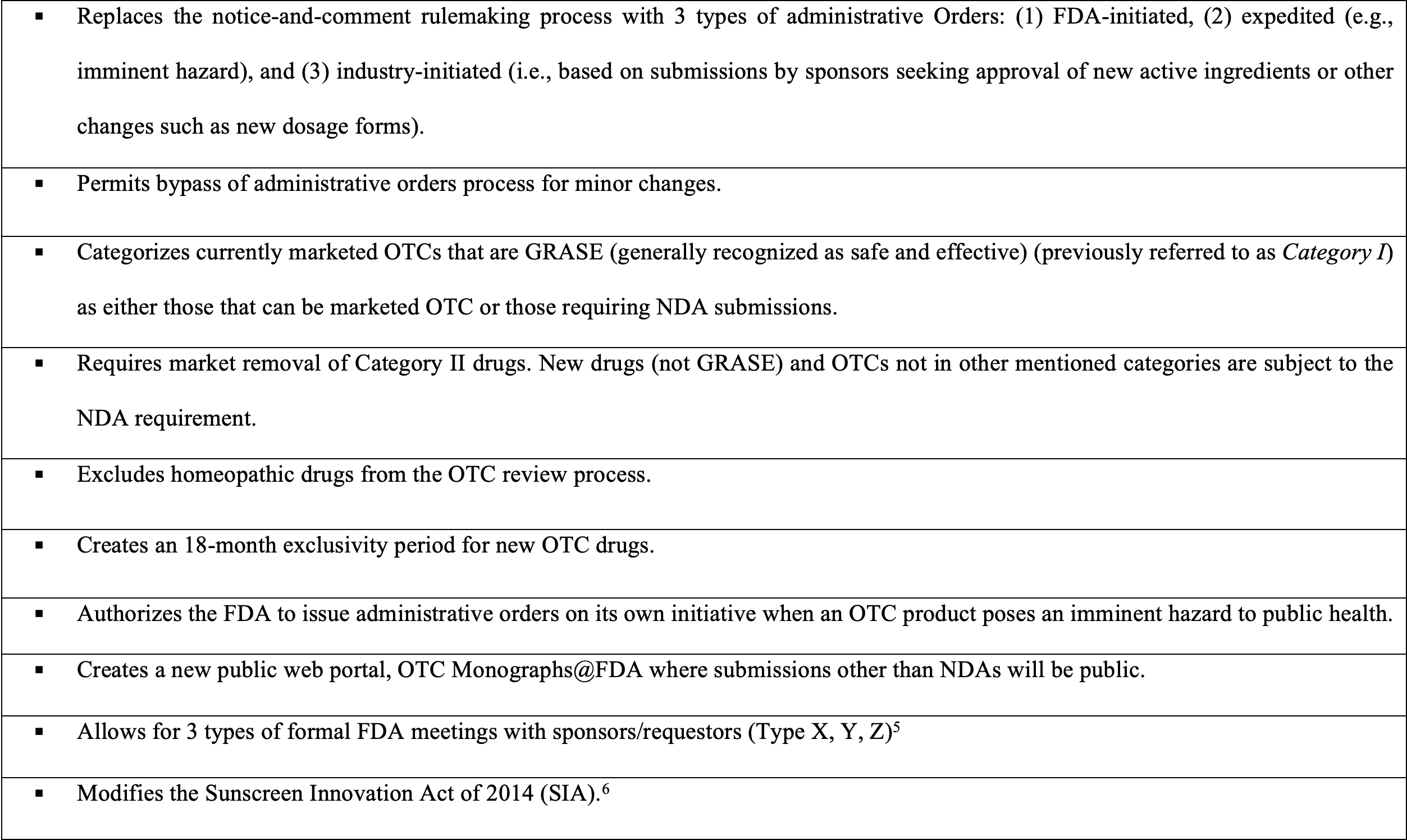Feature
Article
Nonprescription Drug and Cosmetic Regulatory Overhaul: What Pharmacists Need to Know
Author(s):
The crucial role of self-care pharmacy practice requires that pharmacists develop a robust understanding of the implications of the current and proposed regulatory changes for nonprescription drugs.
The regulatory framework for nonprescription OTC drugs in the United States is currently undergoing dramatic reform and modernization.
Credit: makistock - stock.adobe.com

In addition to the sweeping changes to the 50-year-old regulatory processes for nonprescription drugs as a result of the 2020 Coronavirus Aid, Relief, and Economic Security Act (CARES Act),1 the FDA has also taken the initiative to facilitate prescription to OTC switches and has increased the regulatory requirements for cosmetics.
The crucial role of self-care pharmacy practice requires that pharmacists develop a robust understanding of the implications of the current and proposed regulatory changes.
CARES Act
Prior to passage of the landmark legislation, the process for the FDA to finalize an OTC monograph was inefficient and burdensome, resulting in the stifling of innovation, impediments to product label updates, and harmful delays in responding to urgent safety issues. For example, since 2004, the use of cough/cold products has resulted in thousands of reports of adverse events and emergency department visits for infants under 2 years of age.2
A 2007 Citizen’s Petition requested monograph changes for these products to limit for children. The Cough Cold OTC Monograph was not amended by FDA through rulemaking and although manufacturers voluntarily removed infant products from the market and relabeled products to state “do not use in children under 4 years of age," the changes were not mandatory. The CARES Act requires the FDA to evaluate the monograph with respect to children under 6 and revise the monograph accordingly.3
Section 505G4 of the act replaces the multilayered rulemaking process (Advance Notice of Proposed Rulemaking, Tentative Final Monograph, Final Monograph) with an administrative order process for issuing, revising, and amending OTC monographs. These sweeping changes are intended to facilitate the marketing of innovative nonprescription products with new ingredients, dosage forms (e.g., dissolvable films), and combination of drugs. OTC manufacturers will now be required to draft formal applications and pay user fees to have those applications reviewed by FDA. Table 1 details other provisions of section 505G.
Table 1. Important Provisions of the OTC Monograph Reform

Industry may initiate the administrative order process by filing an OTC Monograph Order Request (OMOR) to the FDA. The FDA will review the OMOR, issue a proposed order with a 45-day comment period, and issue a final order. There are 2 types of OMORs: Tier 1 and Tier 2.7
It is expected that most innovative OMORs will be Tier 1 directed to, for example, new ingredients, indications, routes, dosages, or new fixed-dose combination of ingredients. Tier 2 OMORS can be used to modify directions for use and reorder/add to drug facts labels.
Under the SIA, it took the FDA more than a decade to issue non GRASE determinations for only a handful of sunscreen applications it received back in 2002. Under the CARES Act reforms, sunscreen manufacturers can transition their SIA requests to the new administrative order process. The FDA has previously requested clinical trial data and companies may now be incentivized to go the administrative order route because they may be eligible for ingredient exclusivity.
The changes were implemented in 2022 and it is too early to opine on how smoothly the transition to the administrative order process system is going. There are many issues to be worked through, such as how an 18-month exclusivity period for OTCs will occur. Although the changes are intended to streamline and provide incentives for market entry and revisions, they may lead to increased FDA oversight and enforcement activity for OTCs, a class that has traditionally enjoyed relatively lax scrutiny.
FDA Proposed Rule: OTC Products with an Additional Condition for Use (ACNU)
On June 28, 2022, FDA proposed a rule to establish requirements for OTCs that have an ACNU.8 The rule would facilitate switching products from prescription only to nonprescription status, while retaining the prescription version option for patients.
Some drug products could have the same active ingredient, dosage form, strength, route of administration, and indication, with one made available OTC with an ACNU and the other product made available only by prescription. The rule would establish an ACNU for certain prescription products for which the FDA has found that the OTC drug facts label alone is not sufficient to ensure that consumers can appropriately self-select and use a drug product in a nonprescription setting (e.g., statins).
This is somewhat analogous to the risk evaluation and mitigation strategies (REMS) for prescription drugs, which enabled certain prescription drugs with safety issues to be approved for patients with additional requirements for use. Applicants could propose an ACNU that requires consumers to respond to a set of questions on a self-selection test available by either a mobile application or an automated telephone response system to purchase the product. Additionally, the rule establishes additional labeling and post-marketing reporting requirements for an OTC with an ACNU.
Traditionally, OTC products have been for acute self-limiting conditions. With this proposed rule, the FDA has indicated flexibility in allowing for the OTC use of certain prescription medications for chronic conditions or communicable diseases.
The expansion of consumer access to products in a nonprescription setting, impact on patient autonomy, and the potential to improve public health is apparent. Certainly, fewer claims for medical visit costs may benefit payers. However, cost savings for patients may not occur because payers traditionally exclude OTCs from coverage with patients paying out-of-pocket. Additionally, the proposed rule would have enormous potential for the pharmaceutical industry to expand use of prescription products to OTC status.
What will the impact be on community pharmacy? What is abundantly clear is that the essential role that pharmacists play as medication experts has not been appropriately considered in the proposed rule.
The rule effectively nixes the “third class of drugs concept” that has been discussed for decades. Even worse, although the rule would have a profound effect on pharmacy practice, it does not mention pharmacy at all, nor pharmacist oversight or any counseling requirements. Many questions and details with implications for pharmacy need to be addressed and more than 200 comments received on the proposed rule are currently under consideration by the FDA.9
Consumer demand may be massive for certain products, e.g., statins for hypercholesterolemia. Pharmacies may have kiosks or have consumers complete questionnaires, view videos, take assessment quizzes, etc., although not all states permit the sale of medications via kiosks. Operationally, multiple kiosks, different brands of the same drug, and the responsibility of the kiosk/technology functioning properly are areas that need further consideration and discussion with pharmacy stakeholders.
Should OTCs with ACNUs be sold in any location or limited to sale in pharmacies where there is a pharmacist present? Should they be OTC or behind the counter? There is no mention of this in the proposed rule and OTCs are sold in many different venues, including dollar stores and gas stations.
Certainly, the proposal has important ramifications for prescription volume. Pharmacists need to be engaged because the proposed rule fails to recognize the essential role that pharmacists play in assessing the appropriate use and dispensing of medications and ignores operational and logistical issues. Leaving the pharmacist out of the patient selection process and not addressing the multiple issues identified by pharmacy stakeholders creates barriers that will only impede the success of this initiative and create marketplace confusion.
New OTC Labeling Rules
Quantitative labeling of sodium and potassium content of OTC drugs is currently required. For products with more than 5 mg per dose, the FDA recently issued a guidance, clarifying the sodium and potassium labeling requirement further based on dosage and adding phosphorus.10 For example, if the total dosage is 2 tablets and each contains 4 mg of phosphorus, then the total phosphorous would need to be included in the labeling under “Other Information.”
OTC Naloxone and Oral Contraceptives
Since 2006, emergency contraception products have been nonprescription; however, birth control pills, while OTC in many countries (e.g., Mexico, Europe, Latin America), are not. This is primarily because of the safety issue regarding blood clots without sufficient monitoring.
Studies have shown that women in the United States are very interested in access to oral contraceptives without a prescription, that women can accurately identify contraindications to use with simple checklists, and that nonprescription contraception would increase use, with consequent reductions in unintended pregnancy rates. At least one manufacturer has asked FDA to approve a nonprescription birth control pill.
The pill is a progestin minipill, which may carry a lower risk of blood clots, although with less efficacy than estrogen products. Although it is unclear if this application includes an ANCU, the FDA is expected to decide on it in 2023.
The FDA recently approved a naloxone nasal spray that will be available OTC. Other manufacturers have now applied for OTC status and the FDA is slated to decide on the applications within a few months, with OTC versions expected on pharmacy shelves sometime in 2023. Naloxone products that come in higher doses and other forms of the drug for which more safety data are still needed, such as those that come in glass vials and ampules, would still need to be prescribed or dispensed via protocols.
The Modernization of Cosmetics Regulation Act (MoCRA)
The FDA’s current regulatory framework for cosmetics has existed since 1938. MoCRA represents a major overhaul of cosmetic regulation.11
Cosmetics are currently subject to the adulteration and misbranding provisions of the Federal Food Drug & Cosmetic Act, the Poison Prevention Packaging Act, and the Fair Packaging and Labeling Act. Existing standards failed to address chronic harm caused by known carcinogens, such as benzene found in many personal care products, necessitating voluntary recalls in late 2022.
MoCRA adds requirements listed in Table 2, most of which go into effect on December 29, 2023. Cosmetic companies need to implement registration, listing, and compliance programs early in advance of that date. Relabelers and repackagers per se, need not register, but those that perform packaging and repackaging or filling a product container with a cosmetic product must register.
Table 2. New Regulatory Requirements for Cosmetics

Over the past few years, tremendous regulatory overhaul for OTCs with implications for self-care pharmacy practice has occurred. This activity ranges from reforming the cumbersome and slow OTC monograph system to creating a pathway for nonprescription products with an ACNU to exerting greater regulatory oversight over cosmetic products.
About the Author
Martha M. Rumore, PharmD, Esq, MS, LLM, FAPhA, is senior counsel at Frier Levitt.
References
1. P.L. 116-136 (2020).
2. Congressional Research Service.FDA Regulation of Over-the-Counter Drugs: Overview and Issues for Congress. CRS Report R46985. December 10, 2021.
3. 21 C.F.R. Part 341.
4. Section 505G of the FDCA.
5. FDA Guidance. Formal Meetings Between the Food and Drug Administration and Sponsors or Requestors of Over- the-Counter Monograph Drugs. CDER,Feb. 2022.
6. P.L. 113-195, 128 Stat. 2035 (2014).
7. Section 744M(a)(2)(A) of the FDCA.
8. Proposed Rule. Nonprescription Drug Products With an Additional Condition for Nonprescription Use. June 28, 2022; 87 FR 38313; pp. 38313-38331.
9. Docket FDA 2021-N-0862. 200 Comments. Proposed Rule. Nonprescription Drug Products With an Additional Condition for Nonprescription Use.
10. FDA Guidance. Quantitative Labeling of Sodium, Potassium and Phosphorus for Human Over-the-Counter and Prescription Drug Products. CDER, Sept 2022.
11. MoCRA amends Chapter VI of the FDCA.





